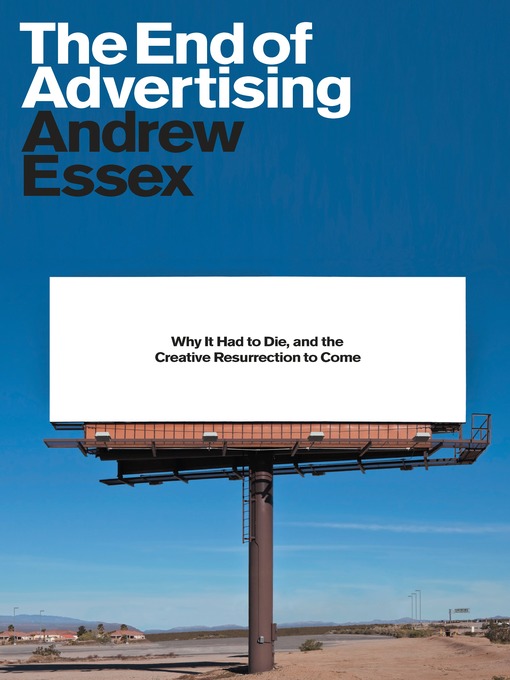
The End of Advertising
Why It Had to Die, and the Creative Resurrection to Come
کتاب های مرتبط
- اطلاعات
- نقد و بررسی
- دیدگاه کاربران
نقد و بررسی

February 20, 2017
Essex, former CEO of advertising agency Droga5, makes a convincing argument that most people find advertising annoying, ads are quietly disappearing from people’s screens due to ad-free TV and Internet ad-blockers, and advertising needs to be reinvented to better serve companies and customers. Essex ambles through these issues with respect to magazines and radio, and offers an instructive history of advertising, including early ads for Ivory Soap (“It floats!”) and Bayer’s introduction of heroin as a painkiller at the turn of the 20th century. He also explores a clear exception to his thesis, which is that ads still dominate TV broadcasts of live sporting events like NFL games. He glosses over direct-mail and TV and movie product placements, and makes no mention of in-theater advertising or online marketing content. His proposal that advertising must be made excellent, interesting, and original—with examples such as the American Girl doll line, The Lego Movie, and New York City’s Citi Bike program—seems to be sound advice, though he shows no evidence that this type of advertising effectively motivates people to buy products and services. Despite these omissions, Essex’s extended soliloquy on advertising’s past, present, and future is informative and enjoyable.

May 1, 2017
The death of advertising requires a creative resurrection.Media have long heard the mantra "change or die," and veteran ad executive Essex, the CEO of Tribeca Enterprises, argues that advertising as we know it is already in its death throes, a victim of the digital technology that it has yet to master. With no apparent irony but maybe some hyperbole, the author hails the advent of "ad blocking, which I have come to regard, heretically, as the greatest thing that has ever happened to the advertising industry." Why? Because it has forced some companies and those charged with the promotion of their products to acknowledge and even embrace the paradigm shift, to recognize that consumers can now bypass anything that doesn't offer value. Some of the results that he praises seem visionary. "The incandescent genius of Lego's adventure in antiadvertising" is how Essex praises The Lego Movie, a critically hailed, crowd-pleasing release that found people paying to see what was essentially an extended ad for the toy company's brand. Not only did Lego increase sales; the movie itself made money, a reversal of the sort of expenditure that promotion represents. Essex also praises the branding of American Girl, a doll series that has become so much more; the stores themselves are moneymaking promotions for the brand, where they have created their own context for the content: "I realized that the American Girl brand had achieved this stranglehold on my daughter's imagination without her ever seeing so much as a single traditional ad for the company. And yet every inch of the store and its attendant content was advertising." Then there's New York's popular Citi Bike kiosk program, "a massive, historic success and a game changer in terms of reinventing advertising," launched at least in part because of "the serendipity in the name Citi Bike. After all, it was just two letters away from Citibank." As Essex succinctly demonstrates, since consumers will continue to buy and companies still have large budgets to promote, ingenuity can find a way to promote value.
COPYRIGHT(2017) Kirkus Reviews, ALL RIGHTS RESERVED.

April 1, 2017
Advertising's troubles started with the dawn of the Internet, according to Essex, who has worked in the industry as a CEO and vice chairman. While its annoyances and encroachment were formerly noticed but tolerated, the invention of software such as Adblock put the power into the hands of consumers to shut off revenue-making ads online, leaving marketers struggling to reach audiences. The death of advertising started with the shift from traditional ads in magazines to digital spaces, where companies could communicate directly to consumers. Essex explores this rift and returns briefly to the historical origins of selling in America. He concludes by examining recent success stories of companies. The problem modern advertisers encounter is the inability to think freshly and imaginatively in the evolving environment and with a younger Millennial consumer base that has different attention spans, values, and expectations. To be successful, businesses need to stop repeating old patterns and to reinvent advertising entirely. The key, argues Essex, is for businesses to zero in on the values of the younger generation and incorporate them into the way we live now. VERDICT A light read with a primary audience of people in business and marketing.--Laurel Tacoma, Fairfax Cty. P.L., VA
Copyright 2017 Library Journal, LLC Used with permission.

























دیدگاه کاربران